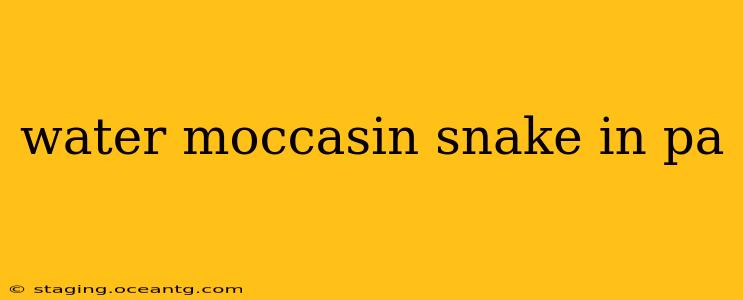The question of whether water moccasins (also known as cottonmouths) live in Pennsylvania often sparks debate. The short answer is no, water moccasins are not native to Pennsylvania. This article will delve deeper into why this is the case, addressing common misconceptions and exploring the snakes you might encounter in the Keystone State.
What is a Water Moccasin (Cottonmouth)?
Before we definitively address their absence in PA, let's clarify what a water moccasin is. The cottonmouth (Agkistrodon piscivorus) is a venomous pit viper known for its distinctive dark, almost black, body and the characteristic white interior of its mouth, which it displays as a defense mechanism. They are semi-aquatic, preferring swamps, marshes, and slow-moving rivers. Their range is primarily in the southeastern United States.
Why Aren't Water Moccasins Found in Pennsylvania?
Pennsylvania's climate and ecosystem simply aren't suitable for cottonmouths. Their preferred warm, humid environment doesn't extend this far north. The state's average temperatures are significantly colder, particularly during winter, making it impossible for cottonmouths to survive and reproduce. Their prey base and suitable habitats are also absent in the majority of Pennsylvania.
What Snakes Are Found in Pennsylvania?
While water moccasins are absent, Pennsylvania is home to a variety of other snake species, some of which might be mistaken for cottonmouths. These include:
- Northern Water Snake (Nerodia sipedon): This non-venomous snake is often confused with cottonmouths due to its similar coloration and semi-aquatic habitat. However, northern water snakes have a much more slender build and lack the characteristic white mouth interior of the cottonmouth.
- Eastern Garter Snake (Thamnophis sirtalis): A common and widespread snake in PA, the eastern garter snake is non-venomous and usually found in more terrestrial habitats. They are identifiable by their distinctive stripes.
- Copperhead (Agkistrodon contortrix): Unlike the cottonmouth, the copperhead is found in Pennsylvania, though their range is more restricted. They are venomous but generally shy and avoid human contact. They are identifiable by their hourglass-shaped markings.
- Rattlesnakes: While rare, some timber rattlesnakes may be found in very specific, isolated locations within the state.
How to Identify Snakes in Pennsylvania
Correctly identifying snakes is crucial for safety. If you encounter a snake in Pennsylvania, avoid approaching it and attempt to observe it from a safe distance. Taking a photograph (if possible without disturbing the snake) can help with identification. Online resources like field guides or websites dedicated to Pennsylvania herpetology can aid in identification. Never attempt to handle a snake unless you are a trained professional.
Are there any venomous snakes in PA?
Yes, while water moccasins are not among them, copperheads and timber rattlesnakes are venomous snakes found within Pennsylvania's borders. It is important to understand that the presence of venomous snakes requires caution and respect for their space.
What should I do if I encounter a snake?
If you encounter a snake in Pennsylvania, the best course of action is to leave it alone and give it space. Avoid approaching the snake and allow it to move away naturally. If the snake is in a place that might present danger to people or pets, contact your local animal control or wildlife removal services.
What should I do if I'm bitten by a snake?
In the unlikely event of a snake bite, seek immediate medical attention. Try to note the characteristics of the snake involved to aid in treatment. Remain calm and follow any instructions provided by emergency services.
Remember, responsible coexistence with wildlife involves respecting their habitats and ensuring our own safety. While water moccasins are absent from Pennsylvania, understanding the snakes that do inhabit the state is vital for responsible enjoyment of the outdoors.
